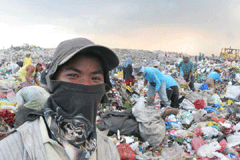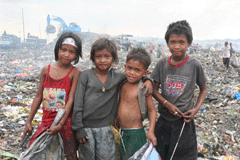Garbage Mountain
Air Date: Week of January 19, 2007

A mangangalahig, or scavenger, atop the 130-foot high garbage mountain at the Payatas Dump, Quezon City, Philippines. (Photo: (c) Matthew Power, 2006)
The local dump is a place many of us visit every once in a while to throw out trash, but around the world, millions of people call it home. At Payatas, a gigantic mountain of garbage outside Manila in the Philippines, adults and children scavenge through the trash daily for treasures such as plastic and computer parts to be sold for more money than the average Filipino citizen earns. Matthew Power traveled to Payatas and wrote about it for Harper’s Magazine. He talks with host Bruce Gellerman.
Transcript
GELLERMAN: For most of us, “out of sight, out of mind,” toss it away and it’s gone. But imagine what really happens to all that trash the world throws away.
POWER: As we come over a rise my first glimpse of Payatas is hallucinatory, a great grey smoky mass that towers above the trees and shanties creeping up to its edge. On the rounded summit a tiny backhoe crawls along a contour seeming to float in the sky.
GELLERMAN: That’s Matthew Power writing about a place called Payatas. It’s just outside Manila, the capital city of the Philippines it’s a gargantuan mountain of garbage.

Matthew Power ((c) Matthew Power, 2006)
GELLERMAN: Matthew Power is a contributing editor at Harper’s Magazine and his recent article “The Magic Mountain: Trickle-Down Economics in a Philippine Garbage Dump” is a riveting journey into a world that few of us can imagine, but that millions of people actually inhabit. It’s the world of garbage pickers people who make their living scouring through the refuse of their countrymen. The residents of Payatas, says Matthew Power, are much like those in shantytowns throughout the developing world.
POWER: Largely they’re people that have migrated from other parts of the Philippines, the sort of rural hinterlands of the Philippine island group, are incredibly poor so a lot of people from the country side, and this is a global phenomenon, a lot of people from the Philippine country side have moved to the boundaries and the perimeters of the larger urban areas. And one of the most plausible means of making a living that they found is to work these enormous garbage dumps.

A mangangalahig, or scavenger, atop the 130-foot high garbage mountain at the Payatas Dump, Quezon City, Philippines. ((c) Matthew Power, 2006)
POWER: In a lot of ways. You can actually make in a given day, they’re called mangangalahigs, that’s the word in Philippino. Um, on a given day you can make about twice the national mean income by scavenging through the trash for recyclables.
GELLERMAN: But they don’t only work on this dump they live next to it.
POWER: Yeah, there is a large shanty town that’s been built up around it and that was actually the reason I first went to Payatas was because of this disaster that happened in 2000, was a section of the dump collapsed and killed 300 people in one of the shanty towns that had been built up on the edge of the dump
GELLERMAN: This mountain of garbage at Payatas must be incredibly toxic the way you describe it, this stuff oozing out of the ground?
POWER: Yeah, it’s a real problem. I mean one of the things is because Payatas originally, 30 years ago, was started as an illegal dump site it was essentially just a ravine that people started dumping garbage in and it metastasized into this enormous mountain of garbage. So it’s never had a liner like a proper garbage dump is supposed to have to keep all the leachate, which is this chemical distillate of all the different things that are in the garbage, from leaking out. So you have this problem that just spreads out into the waterways and flows directly into the Pasig river, which is the main sort of waterway that runs through metro Manila.

A polluted tributary of the Pasig River, below the Payatas dump, in which boys wash plastic bags for recycling. ((c) Matthew Power, 2006)
GELLERMAN: What did it smell like, this mountain of trash?
POWER: It’s funny, you actually begin to get acclimatized to it relatively fast. I mean It smells terrible, as you can imagine. You’re in the tropics so it’s very humid. It rains a lot. And you’re standing on a 150 foot high pile of putrescent garbage. You know there’s food rotting. There’s a lot of burning, um so there’s a lot of plastic burnt smoke in the air, which is also incredibly toxic. It’s filled with dioxin. So it smells terrible. I think if you, you know if you left your garbage out in the sun for a week and then stuck your head inside the bag you’d get a good sense. But by the same token you actually kind of get used to it after a few days.
GELLERMAN: You write about Manila being this sprawling megalopolis. That’s dumping 7,000 tons of debris every day in these dumps. And that this is not unique to Manila. That this is a global problem.
POWER: Yeah, that’s a global phenomenon. At the beginning of the industrial revolution two percent of the world lived in cities. And this year it’s going to be 50 percent and the estimate is by 2050, actually 80 percent of the world will live in these urban areas, and half of that will be slums. Slums like Payatas and Lagos, Nigeria, Mexico City, Cairo, Mumbai, which I lived in India for a year, and there’s a slum on the outskirts of Mumbai called Darvie, which has a million people living in a square mile.

Child scavengers at Pier 18, Manila ((c) Matthew Power, 2006)
POWER: Ah yeah, well I spoke to one sociologist who had done an extensive study on the scavengers in Manila and the statistic he came up with was that they were actually pulling 25 percent of the daily house hold waste out of the waste stream and into recycling. So they’re actually serving an incredibly important economic ecological niche. They’re, you know, taking almost all the usable plastics all the usable metals. They were pulling out parts of computers and reusing them; there’s a whole mini industry of recycling Pentium chips and printer cartridges. Which printer cartridges are like the diamonds that are scattered about inside this garbage. Like if you find one that’s the best day because you can sell them for something on the order of five or six dollars a piece.
GELLERMAN: And that represents what percentage of their daily income?
POWER: Oh, that’d be about twice what you would make on a normal day.
GELLERMAN: So these people are like bottom feeders in a sense. They’re serving a social function. And if they close these dumps or put them off limits to these scavengers what would happen to them? And, I guess, what would happen to us?
POWER: One of the problems when they closed Payatas for a few months was that garbage piled up all over the city. They simply didn’t have anywhere else to bring it. If you put these dumps further out in the countryside the scavenger community will follow the garbage. It’s like a gold rush. They’ll follow it wherever it goes. So the society is pretty resilient. And they’re very good at figuring out what they can do to survive. Which is a phenomenon that’s kind of across the entire ecology of slums all over the world. I mean there’s this tendency to turn them into these UNICEF posters of something to be pitied. What I came away from there with was this real sense of human endurance and the ability to survive and still lead a happy life.
I’m not saying that they shouldn’t have the opportunities to make things better for themselves but I think that by just pitying them you deny them this sort of agency to make something of their lives. And when they’re allowed to sort of organize themselves and help with organizing themselves they actually can do really amazing things and be a big part of you know an ecological mentality. You know, a lot of them are starting to see themselves as recyclers and as understanding that they’re doing a good thing, which empowers them to demand better standards of living for themselves.

An 8 year old boy scavenger at Pier 18, a waste transfer station on the Manila waterfront. ((c) Matthew Power, 2006)
GELLERMAN: Matthew Power is a contributing editor to Harper’s Magazine. His article, The Magic Mountain appears in a recent issue of the magazine. Matthew, thank you very much.
POWER: Thank you.
Links
“The Magic Mountain: Trickle Down Economics in a Philippine Garbage Dump”
Matthew Power’s article appears in the December 2006 issue of Harper’s Magazine
Living on Earth wants to hear from you!
Living on Earth
62 Calef Highway, Suite 212
Lee, NH 03861
Telephone: 617-287-4121
E-mail: comments@loe.org
Newsletter [Click here]
Donate to Living on Earth!
Living on Earth is an independent media program and relies entirely on contributions from listeners and institutions supporting public service. Please donate now to preserve an independent environmental voice.
NewsletterLiving on Earth offers a weekly delivery of the show's rundown to your mailbox. Sign up for our newsletter today!
 Sailors For The Sea: Be the change you want to sea.
Sailors For The Sea: Be the change you want to sea.
 The Grantham Foundation for the Protection of the Environment: Committed to protecting and improving the health of the global environment.
The Grantham Foundation for the Protection of the Environment: Committed to protecting and improving the health of the global environment.
 Contribute to Living on Earth and receive, as our gift to you, an archival print of one of Mark Seth Lender's extraordinary wildlife photographs. Follow the link to see Mark's current collection of photographs.
Contribute to Living on Earth and receive, as our gift to you, an archival print of one of Mark Seth Lender's extraordinary wildlife photographs. Follow the link to see Mark's current collection of photographs.
 Buy a signed copy of Mark Seth Lender's book Smeagull the Seagull & support Living on Earth
Buy a signed copy of Mark Seth Lender's book Smeagull the Seagull & support Living on Earth

